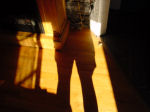I developed  De Quervain’s tenosynovitis or tendonitis or inflammation of the tendons on the thumb side of my left wrist.  This summer I worked hard on learning a particular style of picking and chords on guitar to mimic the playing of San Francisco bay Blues by the Weaves at their 1963 concert in Carnegie Hall, NY. I am taking an anti-inflammatory drug daily, not playing guitar, and occasionally wearing a wrist splint. Here is a collection of links abut developing, dealing with, and preventing tendonitis for guitar players.
-
“Most people don’t think about preventing guitar related injuries until it’s too late. That’s a shame, since most can be avoided with common sense and simple precautions.”
-
“ike most guitarists, I never thought I’d get tendonitis, not to mention several times. One side effect is that, since launching my music career, I’ve fielded hundreds of questions about it. These range from how to avoid it, diagnose it, get treatment (and from whom), do home therapy, and continue with playing – and more importantly, get on with your life.”
-
“Playing guitar can be painful, particularly if you stay at it for hours at a time. To begin with, we must use our bodies in an asymmetrical way to hold the guitar, resulting in muscle imbalances. In addition, we cave in the front of our bodies as we wrap around the instrument and we usually distort our necks and compress our vertebra as well. We risk injury from repetitive motion and we tend to build tension in our necks, arms and hands with extended practice. Even the most body-conscious players can fall victim to pain and injury at times. With some information and a few exercises these problems can be avoided or solved.”
-
“Tendonitis is a problem always lurking around the corner for string musicians. It can strike when you least expect it. It is an inflammatory condition of a tendon, often at a joint, especially the wrist, knee, or elbow. It is caused by tearing and abrasions of a tendon due to overwork under conditions of high muscle stress. It is typically brought on by repeated controlled movements, and is an occupational hazard of musicians, typists, carpenters, assembly line workers, tennis players, and computer game nuts.”


Post a Comment